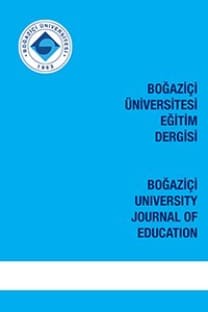Exploring the Relationship between Annotation Use of EFL Learners and Their Learning Styles
This study explores the relationship between (perceptual and cognitive) learning styles and the use of
Anahtar Kelimeler:
Hypermedia, learning style, annotation use
Exploring the Relationship between Annotation Use of EFL Learners and Their Learning Styles
This study explores the relationship between (perceptual and cognitive) learning styles and the use of
hypermedia annotations by intermediate EFL learners while reading a hypermedia text. The participants were
44 EFL adult learners studying English for academic purposes. Data were collected through a software
tracking tool, a learning styles survey and interviews. Results did not indicate a significant relationship,
suggesting that learners with different learning styles had similar patterns in using hypermedia annotations,
which in turn suggests that hypermedia environments can accommodate for various learning styles.
Keywords:
Hypermedia, learning style, annotation use,
___
- Allan, D. (1992). Oxford placement test. Oxford: Oxford University Press.
- Ariew, R. (1999). Arisoft.
- Chiquito, A. B., Meskill, C., & Renjilian-Burgy, J. (1997). Multiple, mixed, and malleable media. In M. D. Bush (Ed.). Technology-enhanced language learning (47-76). Illinois: National Textbook Company.
- Claxton, C. S., & Murrell, P. H. (1988). Learning styles. ERIC Higher Education (ERIC Document Reproduction Service No. ED301143).
- Cordell, B. J. (1991). A study of learning styles and computer-assisted instruction. Computers in Education. 16(2), 175-183.
- Dunn, R., Giannitti, M.C., Murray, J.B., Rossi, I., & Quinn, P. (1989). Grouping students for instruction: Effects of learning style on achievement and attitude. Journal of Social Psychology. 130 (4), 485-494.
- Ehrman, M. E., Oxford, R. (1990). Adult language learning styles and strategies in an intensive training setting. The Modern Language Journal, 74, 311–327.
- Ellis, R. (1989). Classroom learning styles and their effect on second language acquisition: A study of two learners. System, 17, 249–262.
- Erçetin, G. (2003). Exploring ESL learners’ use of hypermedia reading glosses. CALICO Journal, 20(2), 261-283.
- Ester, D. P. (1995). CAI, lecture, and student learning style: The differential effects of instructional method. International Society for Technology in Education. 27 (12), 129-140.
- Kommers, P. A. M., Grabinger, S., & Dunlap, J. C. (1996). Hypermedia learning environments: Instructional design and integration. New Jersey, NJ: Lawrence Erlbaum.
- Kramsch, C., & Andersen, R. W. (1999). Teaching text and context through multimedia. Language Learning, Technology, 2 (2), 31-42.
- Liu, M., & Reed, W. M. (1994). The relationship between the learning strategies and learning styles in a hypermedia environment. Computers in Human Behavior, 10, 419-434.
- Mayer, R. E., & Sims, V. K. (1994). For whom is a picture worth a thousand words? Extensions of a dual-coding theory of multimedia learning. Journal of Educational Psychology, 86, 389-401.
- O'Connor, T. (1997). Using learning styles to adapt technology for higher education. Terra Haute, IN: Indiana State University. Retrieved September 28, 2002 from, http://web.indstate.edu/ctl/styles/learning.html.
- Oxford, R. L. (1993). Style analysis survey (SAS). Tuscaloosa, AL: University of Alabama.
- Oxford, R. L., & Ehrman, M.E., (1993). Second language research on individual differences. Annual Review of Applied Linguistics, 13, 188¯205.
- Plass, J. L., Chun, D. M., Mayer, R. E., & Leutner, D. (1998). Supporting visual and verbal learning preferences in a second-language multimedia learning environment. Journal of Educational Psychology, 90(1), 25-36.
- Raschio, R. A. (1990). The role of cognitive style in improving computer/assisted language learning. Technologically-Assisted Language Learning, 73, 534- 541.
- Reid, J. (1987). The learning style preferences of ESL students. TESOL Quarterly, 21, 87-111.
- Reid, J. (1998). Preface. In J. Reid (Ed.). Understanding learning styles in the second language classroom. Englewood Cliffs, NJ: Prentice Hall.
- Ross, J., & Schulz, R. (1999). Can computer-aided instruction accommodate all learners equally? British Journal of Educational Technology, 30(1), 5-24.
- Skehan, P., (1991). Individual differences in second language learning. Studies in Second Language Acquisition, 13, 275¯298.
- Wintergerst, A. C., DeCapua, A., & Itzen, C. R. (2001). The construct validity of one learning styles instrument. System. 29(3), 385–403.
- Retrieved May 12, 2002 from, http://www.sciencedirect.com.
- ISSN: 1300-9567
- Yayın Aralığı: Yılda 2 Sayı
- Başlangıç: 1976
- Yayıncı: Boğaziçi Üniversitesi
Sayıdaki Diğer Makaleler
Aile Altyapısı, Ebeveyn Beklentileri, Okul Seçimi ve Öğrenci Performansı
Güzver YILDIRAN, Şükran İLİMSEVER BAŞARIR
Exploring the Relationship between Annotation Use of EFL Learners and Their Learning Styles
Family Background, Parental Expectations, School Choice and Student Performance
